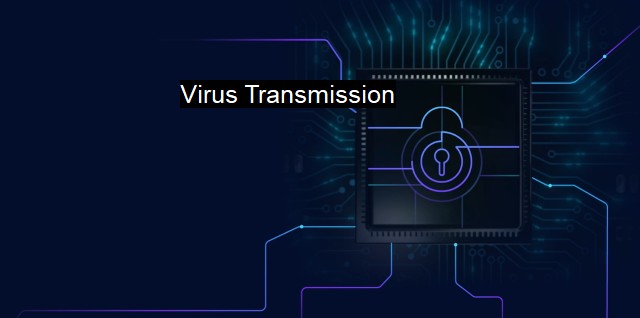What is Virus Transmission?
Understanding Virus Transmission: Methods and Best Practices for Prevention in Cybersecurity and Antivirus
The concept of virus transmission is of paramount importance. This process encompasses how malicious software, commonly referred to as malware or 'virus', is able to move from one device to another. Gaining an understanding of how this transmission takes place is critical in ensuring protection against such security threats.A computer virus, akin to a biological virus, has the ability to replicate itself on an infected computer and has the potential to corrupt system files, disrupt performance, and access personal data. Like their biological counterparts, computer viruses are primarily conceived through entities called 'virus writers' who design their creations with specific intentions, typically to inflict harm or carry out certain unauthorized operations.
For efficient transmission, viruses exploit the numerous weaknesses inherent within a computer network or system. These vulnerabilities could be as simple as a lapse in user vigilance, or as complex as a hole in the network's security model. Either way, these security gaps provide the virus with an opportunity to attach itself onto files or programs and thus perpetuate its existence through transmission.
One of the most common ways in which viruses spread is via email attachments. Unsuspecting users open these infected attachments which execute the hidden malicious program in their system. The situation worsens when the virus begins altering and distributing itself via the user's own email address book, thus potentially affecting a large number of people. In this way, a single infected user can inadvertently act as the carrier to spread the virus to numerous others.
Another prevalent mode of virus transmission is through Internet downloads. Malicious websites often disguise viruses as downloadable software or multimedia content. The instant a user downloads and opens the file, the virus springs into action, infecting the user's computer to either gain access to sensitive data or simply cause havoc on the system.
Viruses can also ‘piggy-back’ on other software installations. Sometimes, when a user installs software from an unverified source, there might be a hidden virus bundled with the software package. As soon as this software is installed, the virus too finds its new residence in the unsuspecting user's system.
Physical transmission is another form of virus spread, especially from portable storage devices like USB sticks and SD cards. If these devices picked up viruses from infected systems, then connecting them to a clean system would straight away transmit the virus.
With virus transmission becoming ever more sophisticated, so too have the antivirus programs that are tasked with preventing them. Antivirus software is key in protecting against viruses; it patrols a user's system for any known threats and is designed to remove them, or at least isolate them.
Antivirus mechanisms work by using complex algorithms to detect any unusual activity, cross-checking any such activity against a continuously updated database of identified threats. Some advanced models would implement active user warnings when suspicious websites or downloads are encountered, thus, giving the user the opportunity to avoid the threat altogether.
Regular software updates and patch installations form another important aspect of securing systems against virus transmission. These updates essentially 'patch up' the vulnerabilities in the system, making it harder for viruses to crawl through. Installing a reliable firewall and practicing safe browsing and downloading behaviors are also important measures to protect against the threat of virus transmission.
The threat posed by virus transmission cannot be understated. It is important for both individuals and businesses, large and small, to educate themselves about this threat. Vigilance, decision-making consciousness, and an efficient antivirus system are some of the essential tools needed to ensure optimal cybersecurity.
To effectively deal with virus transmissions in the intricate landscape of today's cybersecurity, means staying updated with emerging threats, employing a robust antivirus program, performing regular software updates, and practicing safe browsing and email habits. As the adage goes, 'Prevention is better than cure', especially in the realm of cybersecurity where a small prevention step can go a long way in protecting valuable data and maintaining system integrity.

Virus Transmission FAQs
What is virus transmission in the context of cybersecurity and antivirus?
Virus transmission is the process of spreading malicious software from one system to another. It can happen through various means such as email attachments, infected files or downloads, or even through social engineering.How can virus transmission be prevented?
Virus transmission can be prevented by using antivirus software, keeping software and operating systems up-to-date, avoiding suspicious emails or links, and by being cautious while downloading or sharing files online.What are the consequences of virus transmission?
The consequences of virus transmission can vary, but they can include compromised data or personal information, system crashes, slow performance, and in some cases, total system failure.How can I know if my system has been infected by a virus?
Some of the signs of an infected system include slow performance, strange pop-ups, alerts or messages, unauthorized access or changes to files, and increased network activity. If you suspect that your system may have been infected, it is important to run a virus scan and to seek professional assistance.| | A | | | B | | | C | | | D | | | E | | | F | | | G | | | H | | | I | | | J | | | K | | | L | | | M | |
| | N | | | O | | | P | | | Q | | | R | | | S | | | T | | | U | | | V | | | W | | | X | | | Y | | | Z | |
| | 1 | | | 2 | | | 3 | | | 4 | | | 7 | | | 8 | | |||||||